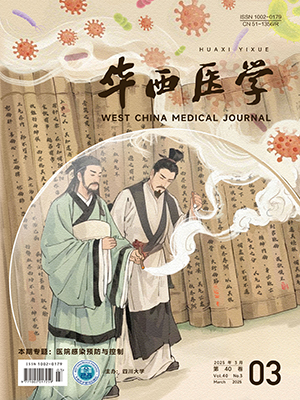| 1. |
唐康来, 杨柳, 李起鸿. 关节镜下清理及术后持续灌洗治疗化脓性膝关节炎[J]. 中国矫形外科杂志, 2003, 11(3): 204-206.
|
| 2. |
Nade S. Acute septic arthritis in infancy and childhood[J]. J Bone Joint Surg Br, 1983, 65(3): 234-241.
|
| 3. |
Wirtz DC, Marth M, Miltner O, et al. Septic arthritis of the knee in adults: treatment by arthroscopy or arthrotomy[J]. Int Orthop, 2001, 25(4): 239-241.
|
| 4. |
Ogilvie-Harris DJ, Fitsialos DP. Arthroscopic management of the degenemative knee[J]. Arthroscopy, 1991, 7(2): 151-157.
|
| 5. |
Canale ST, Beaty JH. 坎贝尔骨科手术学[M]. 王岩, 蔡谞, 李众利, 等, 译. 11版. 北京: 人民军医出版社, 2009: 589-592.
|
| 6. |
赵金忠, 蒋垚, 沈灏, 等. 通过关节镜技术治疗早期膝关节化脓性关节炎[J]. 中华骨科杂志, 2002, 22(8): 474-476.
|
| 7. |
敖英芳, 刘玉杰, 崔国庆, 等. 膝关节镜手术学[M]. 北京: 北京大学医学出版社, 2004: 51.
|
| 8. |
Lysholm J, Gillquist J. Evaluation of knee ligament surgery results with special emphasis on use of a scoring scale[J]. Am J Sports Med, 1982, 10(3): 150-154.
|
| 9. |
张抒, 张强, 张军, 等. 关节镜下治疗急性化脓性膝关节炎[J]. 中国矫形外科杂志, 2006, 14(1): 73-74.
|
| 10. |
Johnson MW. A cutek neeef usions: a systematicapp roac htod iagnosis[J]. Am Fam Physician, 2000, 61(8): 2391-2400.
|
| 11. |
Morrey BF, Marth M, Milmer O, et al. Septic arthritis in children[J]. Orthop Clin North Am, 1975, 6(4): 923-934.
|
| 12. |
王创利, 朱贤, 王黎明. 关节镜清理加置管冲洗治疗急性化脓性膝关节炎 21例疗效观察[J]. 苏州大学学报: 医学版, 2004, 24(5): 725, 727.
|
| 13. |
杨蒙. 双管闭式灌洗治疗化脓性膝关节炎21例[J]. 临床骨科杂志, 2004, 7(2): 224-225.
|
| 14. |
肖谦, 向芳友, 刘志远. 关节镜下清理及术后持续灌洗引流治疗膝关节骨性关节炎并化脓感染[J]. 南华大学学报: 医学版, 2007, 35(5): 732-734.
|
| 15. |
孙羽, 刘其明. 关节镜技术在化脓性膝关节炎治疗中的应用[J]. 临床骨科杂志, 2008, 11(3): 259-261.
|
| 16. |
陈琼, 任乐夫. 化脓性膝关节炎关节镜下治疗[J]. 中国医疗前沿, 2008, 3(18): 54-55.
|




